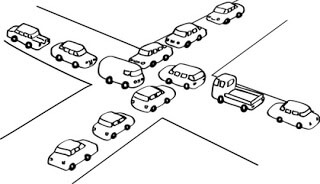What is Deadlock?

- System Model
- Deadlock Characterization
- Methods for Handling Deadlocks
- Deadlock Prevention
- Deadlock Avoidance
- Deadlock Detection
- Recovery from Deadlock
- Combined Approach to Deadlock Handling
A set of blocked processes each holding a resource and waiting to acquire a resource held by another process in the set.
Example
System has 2 tape drives.
P1 and P2 each hold one tape drive and each needs another one.
Example
semaphores A and B, initialized to 1
P0 P1
wait (A); wait(B)
wait (B); wait(A)
Meaning of Deadlock
A set of blocked processes each holding a resource and waiting to acquire a resource held by another process in the set.

Example
A system having 2 tape drives or cd drives.
Here is a ppt which contains everything related to Deadlock, images, examples, problems,
you can view the ppt directly without downloading it,
Bridge Crossing Example
- Traffic only in one direction.
- Each section of a bridge can be viewed as a resource.
- If a deadlock occurs, it can be resolved if one car backs up (preempt resources and rollback).
- Several cars may have to be backed up if a deadlock occurs.
- Starvation is possible.
Resource types R1, R2, . . ., Rm
CPU cycles, memory space, I/O devices
Each resource type Ri has Wi instances.
Each process utilizes a resource as follows:
- request
- use
- release
Deadlock Characterization
Deadlock can arise if four conditions hold simultaneously.
Mutual exclusion: only one process at a time can use a resource.
Hold and wait: a process holding at least one resource is waiting to acquire additional resources held by other processes.
No preemption: a resource can be released only voluntarily by the process holding it, after that process has completed its task.
Circular wait: there exists a set {P0, P1, …, P0} of waiting processes such that
P0 is waiting for a resource that is held by P1,
P1 is waiting for a resource that is held by P2, …,
Pn–1 is waiting for a resource that is held by Pn,
and P0 is waiting for a resource that is held by P0.
Resource-Allocation Graph
A set of vertices V and a set of edges E.
V is partitioned into two types:
P = {P1, P2, …, Pn}, the set consisting of all the processes in the system.
R = {R1, R2, …, Rm}, the set consisting of all resource types in the system.
request edge – directed edge P1 -> Rj
assignment edge – directed edge Rj -> Pi
Basic Facts
If graph contains no cycles -> no deadlock.
If graph contains a cycle
if only one instance per resource type, then deadlock.
if several instances per resource type, possibility of deadlock
Methods for Handling Deadlocks
- Ensure that the system will never enter a deadlock state.
- Allow the system to enter a deadlock state and then recover.
- Ignore the problem and pretend that deadlocks never occur in the system; used by most operating systems, including UNIX.
Also read 10 awesome tips for viva and practicals
Deadlock PreventionMutual Exclusion – not required for sharable resources; must hold for nonsharable resources.
Hold and Wait – must guarantee that whenever a process requests a resource, it does not hold any other resources.
Require process to request and be allocated all its resources before it begins execution, or allow process to request resources only when the process has none.
Low resource utilization; starvation possible.
No Preemption – If a process that is holding some resources requests another resource that cannot be immediately allocated to it, then all resources currently being held are released.
Preempted resources are added to the list of resources for which the process is waiting.
Process will be restarted only when it can regain its old resources, as well as the new ones that it is requesting.
Circular Wait – impose a total ordering of all resource types, and require that each process requests resources in an increasing order of enumeration
Deadlock
Avoidance
Simplest and most useful model requires that each process declare the maximum number of resources of each type that it may need.
The deadlock-avoidance algorithm dynamically examines the resource-allocation state to ensure that there can never be a circular-wait condition.
Resource-allocation state is defined by the number of available and allocated resources, and the maximum demands of the processes.
Safe State
When a process requests an available resource, system must decide if immediate allocation leaves the system in a safe state.
System is in safe state if there exists a safe sequence of all processes.
Sequence <P1, P2, …, Pn> is safe if for each Pi, the resources that Pi can still request can be satisfied by currently available resources + resources held by all the Pj, with j<I.
If Pi resource needs are not immediately available, then Pi can wait until all Pj have finished.
When Pj is finished, Pi can obtain needed resources, execute, return allocated resources, and terminate.
When Pi terminates, Pi+1 can obtain its needed resources, and so on.
Basic Facts
If a system is in safe state no deadlocks.
If a system is in unsafe state possibility of deadlock.
Avoidance ensure that a system will never enter an unsafe state.
Resource-Allocation Graph Algorithm
Claim edge Pi => Rj indicated that process Pi may request resource Rj; represented by a dashed line.
Claim edge converts to request edge when a process requests a resource.
When a resource is released by a process, assignment edge reconverts to a claim edge.
Resources must be claimed a priori in the system.
Resource-Allocation Graph For Deadlock Avoidance
If you are facing any problems viewing the document please comment below
Here are some other programs of DSP Matlab
Discrete fourier transform
Modulo operator
Linear Convolution





